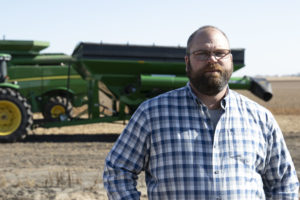
Partnerships That Drive Success
Guests: Todd Arduser, Kevin Poppel
In this episode of Channel Chat, farmer Kevin Poppel talks about the relationships and advice that have helped him find success in farming.
Listen to Episode
 Ag Over Easy Podcast
Ag Over Easy Podcast
The much-anticipated USDA Crop Production Report is out and grain marketing expert Matt Bennett is weighing in on the results in this episode of Channel Chat. Tune in to find out what the February 2019 report means for farmers.


Matt Bennett is not only one of the industry's most respected grain marketing consultants but he's also a farmer himself. With a 3,000-acre corn and soybean farm, Matt understands firsthand the challenges and risks involved in being a farmer. Matt takes his decades of successful experiences, on and off the farm, to provide you with his time-proven approach to grain marketing.
Pam Fretwell
Hello, everyone and welcome to another episode of "Channel Chat." I'm your host, Pam Fretwell. And today with me, I'm excited to have again grain marketing expert Matt Bennett back on our podcast. Now, remember, if you like what you hear on our podcast, make sure that you hit that Subscribe button so that anytime we release a new episode of "Channel Chat," you'll be the first to know about it.
Well, Matt, today, we wanna go over some of the massive amounts of information that's been released today. And the reason why I say that, since the government shutdown, we've seen a lot of backlog reports finally, from the USDA being released, but we didn't even have that January report. Do you think that that made a difference in today and how it's being absorbed by the markets or what's going on? Let's kind of get in to what was said and then maybe people's reactions to that.
Matt Bennett
Well, you know, coming in to the report, that was the perception, that a huge data dump that we were gonna be looking at was gonna end up being the catalyst for a fair amount of volatility, a lot of swings, everyone trying to figure out which data to focus upon. And then you came in here at 11:00 for the report and a few things jump out at you. But the one thing that I wanted to point out to most of the people that I've been talking to lately, on some of the channel meetings and other meetings that I've been putting on is that everyone's eyes are gonna end up being focused upon supply and demand, what the security outlook like...
Because the first look, if you just look at yield, shoot, you know, we dropped the cornmeal two-and-a-half bushels. So getting corn from 178.9 down to 176.4, that's a pretty big drop. And if that was the first thing that you might look at, you might have said, "Holy cow, this is some very friendly report." You know, you start looking at the carry-out, saying ... for corn. It certainly wasn't a bearish number, by any means. We dropped from 178 down to 173, but some people were hoping for less than a 17, so world stocks, pretty much a nonevent, the quarterly stocks for December 1st were actually a little bit friendly, but that's what you have. A little friendly, a non-event, and in the grand scheme of things, we ended up settling the day without a whole lot of fanfare.
Pam Fretwell
And the beans, they were down a little bit too, and Argentina had a lot lower production than we thought they were gonna have. And that's good as far as...because we got a lot of soybeans out there.
Matt Bennett
Yeah, absolutely. You know, the thing that I'd like to point out, you know, from a world perspective on soybeans, we did drop, to your carry number, down to 106 million-metric ton, which was a large drop from 115 we had in December. That would appear to be friendly, but you keep in mind that coming into the '17-'18 marketing year, we had 97.5 million metric tons of soybeans in the world. So yes, we dropped back from more...we thought we were gonna have, as far as December was concerned. But you know, at the same time, we've got all kinds of beans. And so first, you can't get themselves too bold up there. We got to keep in mind, in the grand scheme of things, that we're not running into any sort of global shortage when it comes to soybeans.
Pam Fretwell
And I think that's part of the reason or the effect that we have of these USDA reports is that the farmers are really kind of seeing, "Okay, does this help me with my planting intentions," and did this report help anybody today?
Matt Bennett
Well, that's a wonderful question, and I think that's something that can be debated for quite some time. With me looking at it, from my being at this point, I've got to ask myself a few questions. You know, if we were to come out with a very bullish report today, with regards to corn, you know, what would that have done to this time of marketing year we're looking at? What kind of impact would that have on acreage? Because it's no secret, especially the western corn belt struggled with the very wet fall, harvest was tough, didn't get a lot of field work done, not to mention, not very many people in the entire corn belt was able to put a whole lot of nitrogen on. And again, it's no secret, nitrogen costs have gone up substantially since last fall.
And so there are some real questions and real concerns already on what kind of acreage we might be looking at, but those questions and concerns could be answered pretty quickly with a very sharp rally in corn. Today doesn't suggest that we're gonna see a sort of sharp rally in corn, previous to planting, unless something comes up that none of us are currently looking at. So we didn't get that catalyst for the rally that we were hoping for.
And so that question for me is what does this mean? I think that when you keep bean prices stabilized, like we saw today, in corn prices, not taking off and going higher, that would suggest to me that acreage switching might not be as vast as some people have said that it might be. And so, as far as I'm concerned, this might have been a really good report in the grad scheme of things because I'm not so sure that you are able to pull the kind of corn acres from soybeans given the current price ratio that we're looking at.
And so that is gonna put a fair amount of pressure this year, in my opinion, on the corn market. We end up with a 3 million-acre or less switch to have really, really good weather over the summer because there's a lot of questions marks with regards to this crop.
Pam Fretwell
So I know you do a lot of meetings across the country. What are farmers telling you about getting ready to plant corn this spring?
Matt Bennett
So you know, I was just in Iowa on the 7th of February, the day before the report, and bottom line, the producers that I talked to, they suggest we still want to plant as much corn as we originally intended on but we've got a lot of question marks. We're gonna try to get the corn planted, but it's probably not gonna be in the ideal addition because most of the producers I spoke with did not get much tillage done. And so yes, we may get the acreage planted, but if they're not planted in the ideal conditions that we have in the last couple of years, we're not really setting the framework for a bumper crop. And I tell you what, with the kind of demand that we've built into this corn usage situation, boy, we have to be well aware that if acreage is anything short of a 3 million or more switch, then the heat is really gonna be on.
We need this spring to be a good early spring, where we can get a fair amount of work done. There's gonna be a major strain on the nitrogen infrastructure and anhydrous ammonia in my part of the world, did not get put on this past fall. So there's gonna be a lot of significant challenges ahead. I think the market is gonna be well aware of that. So next spring could be a little more highly scrutinized this year than we've seen in the past.
If you add on top of that any sort of ... weather market which we didn't get in 2018, and I don't know that I remember two years in a row where we didn't have some sort of a summer weather scare. So I think we're setting this market up for, you know, a decent amount of volatility moving forward.
Pam Fretwell
How many opportunities for volatility, then, do you think we have? Because obviously, we thought we were gonna have some good things happen today, and it just didn't happen. Does that have to do with all of these...the new tariffs and the talks and all those different kinds of things? Has that got an impact on it too?
Matt Bennett
Yeah, I believe that it does. I mean, there's certainly a cloud hanging over the market. If we already had a deal made with China that they were actually gonna buy, for instance, a set amount of soybeans and corn which has been discussed, I don't think there's any question that this report would have maybe been viewed in a little more favorable light. I just think that there's a little bit of a cloud hanging over us for the time being.
And so we certainly want to see something kinda come to a close here before March 1st. We don't want to see any additional increase in tariffs again because if we do, I think it's gonna be hard on the economy as a whole. But certainly, ag economy is not gonna be spared in that matter. So definitely a fair amount of concern there.
And I think some of the money that could be flowing into these commodities right now, probably sitting on the sidelines in a bit of a latency approach. But I think in the grand scheme of things, given the supply and demand fundamentals for the U.S. situation, our stocks to use ratio is as tight as it's been in quite some time. And so even if we still have this cloud hanging over us, at some point, the market could come take over and lead to a price discovery system that is gonna end up driving prices higher if we have any sort of inclement weather here in 2019.
Pam Fretwell
So, Matt, another subject we haven't even talked about really is the government shutdown. They're talking about possibly having another one on the 15th. What kind of an impact could that have on our farmers and the markets going forward?
Matt Bennett
The first shutdown, we certainly missed out on the January crop report, which is what made this February crop report all the more interesting. Typically, the February crop report is kind of a no big deal type situation. This year though, we rolled a whole bunch of data, you know, into this one report. So you ask yourself, what about the March report? March report's not a huge deal. What's the big deal is that the end of March, whenever we get the planting intentions report, which is probably one of the, if not, the biggest report that we see whenever it comes to volatility. There's a lot of anticipation there.
And so if we would have some sort of a shutdown that would last, you know, six to seven weeks, that would be a huge report to miss and it would be very hard on the trade, in my opinion, maybe one of the tougher things that we would have to get across. Because it typically sets the tone for the market, especially in that early spring time period. And so I certainly don't want to see something like that happen, but as far as the political situation goes, I wouldn't have a clue to tell you whether we're gonna be looking at that happen or not. I just hope that it doesn't.
Pam Fretwell
All right. Well, Matt, thanks again for joining us on our podcast today. It's always exciting and informative to hear your insights on this grain marketing topics. And don't forget, if you've enjoyed our discussion today, make sure that you sign up for Matt's weekly grain marketing emails. You can do that by visiting www.channel.com and get Matt's insights delivered directly to your inbox. And finally, don't forget to subscribe so you never miss another episode of our "Channel Chat" podcast. Thanks for being with us today. I'm Pam Fretwell.

Guests: Todd Arduser, Kevin Poppel
In this episode of Channel Chat, farmer Kevin Poppel talks about the relationships and advice that have helped him find success in farming.
Listen to Episode

Guests: Colby Woods, Jessica Grubbs
As technology in agriculture continues to evolve, Channel Seedsman Colby Woods wanted to get ahead of the pack and offer drone scouting to his farmers in Eastern Nebraska. We caught up with Colby in Wahoo, Nebraska, along with Sentera Sales and Training Specialist Jessica Grubbs. Listen in this episode of Channel Chat.
Listen to Episode